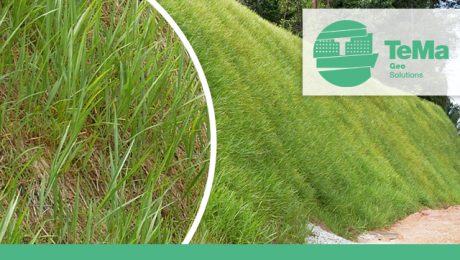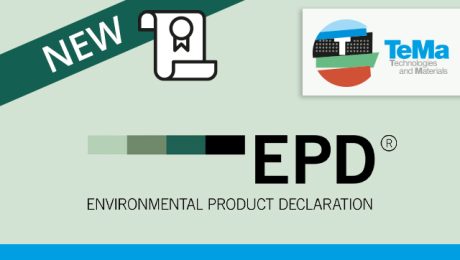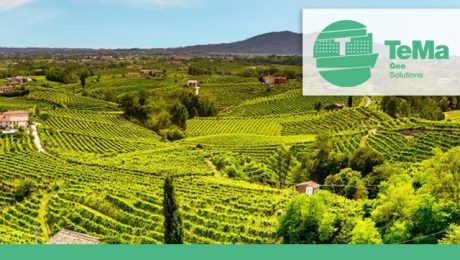Controlling surface erosion with biomats and geomats
Soil erosion is an almost inevitable natural phenomenon that has become a greater concern in recent years due to the worsening climate situation – in Italy, for example, 132 extreme weather events were recorded between January and July 2022, a higher number than the annual average over the last decade – combined with long periods of drought.
Strong winds, heavy rain, hail and runoff tend to remove the surface layer of exposed soils, which often include organic matter and seeds. Climate change facilitates erosion, making it not only inevitable but also hazardous if left uncontrolled.
It’s essential to counter or mitigate the phenomenon: soil provides us with food, biomass and raw materials; human activities take place on it and it’s part of the landscape and our cultural heritage.
Which structures are more subject to surface erosion?
The areas of application most affected by the erosive action of the climate are:
- slopes and the sides of landfills and contaminated sites, and those that have been grassed for appreciable aesthetic improvement;
- reinforced earth structures, more specifically terracing in vineyards and the embankments of canals or rivers;
- ascending/descending ramps from flyovers, tunnel entrances and noise barriers on roads and railways;
- dry, rocky slopes, of all angles, that shape the terrain of Italy.
The effects of surface erosion
The uncontrolled removal of the surface topsoil and the failure of vegetation to take root results in ‘thinning’ of the soil and a risk to the stability of sloping areas.
What can be done to prevent surface erosion?
We should begin by pointing out that a case-by-case assessment is required that considers many variables, such as the nature and uniformity of the soil, the slope gradient, the type of slope (dry or rocky) and the weather conditions in the area where intervention work is to be carried out.
In general, vegetation, whatever type it is, has a natural ability to protect soils from erosion. So the best course of action is to quickly encourage grassing and then apply biodegradable mats made of jute, straw, coconut and cellulose fibre, which can also be pre-seeded.
TeMa Geo Solutions recommends biomats such as Ecovermat, Ecovermat P and PC, and Ecovernet.
Alternatively, or combined with these, synthetic geomats, mainly made of polymer monofilaments, can be used.
Once laid, they are covered with another layer of soil: in this way, the roots of growing vegetation will become entangled with the geomat, creating an almost permanent erosion protection system.
Once again, TeMa Geo Solutions offers a wide range of geomats to choose from.
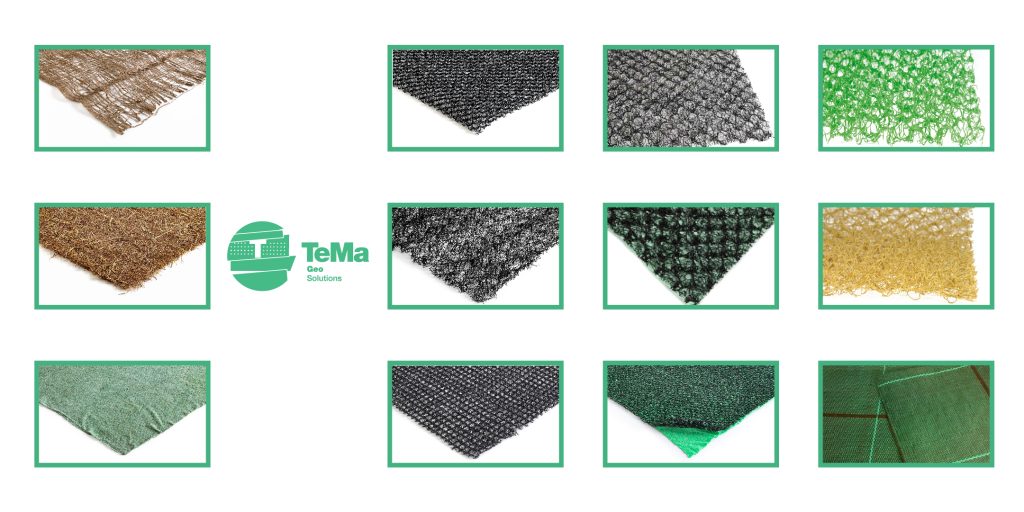
Uncertain about what to choose? We can help you. CONTACT US!
- Published in Erosion mats, GEO, Landfills, Reinforced earth structures, Reinforced earth structures - Erosion control, Roads
TeMa even more transparent about sustainability
With the new EPD certification, TeMa Technologies and Materials provides information about the level of sustainability of its products: this includes most of the membranes and geocomposites manufactured on its production lines. For 30 years, TeMa has regarded environmental protection as a duty and obligation towards the community and future generations.
What is EPD and what is analysed to obtain it?
The Environmental Product Declaration (EPD) is a document that provides specific data on the life cycle of products or a service. It measures the impacts that the production and life phases of a product have on the environment by means of a Life Cycle Assessment to determine the consumption of resources such as water, materials and energy.
It is voluntary and verified by the independent third party SGS so that certified declarations can be given to clients.
International acknowledgement
The EPD document is internationally acknowledged, as it complies with ISO standards. This ensures use, credibility and stability over time, making the data collected available for use in any type of environmental management system and providing information for environmental certification protocols for buildings and infrastructures.
Which product lines from TeMa Building Solutions are EPD certified?
The products having obtained EPD certification are:
- the studded membrane line, which includes Membrana Nera, Membrana Nera Geo, T-Kone, Tefond, HDD, TM and MD;
- the monofilament drainage line comprising Q-Drain C and Q-Drain ZW;
- the anti-erosion and reinforcement geomat line, which includes K-Mat and X-Grid AM.
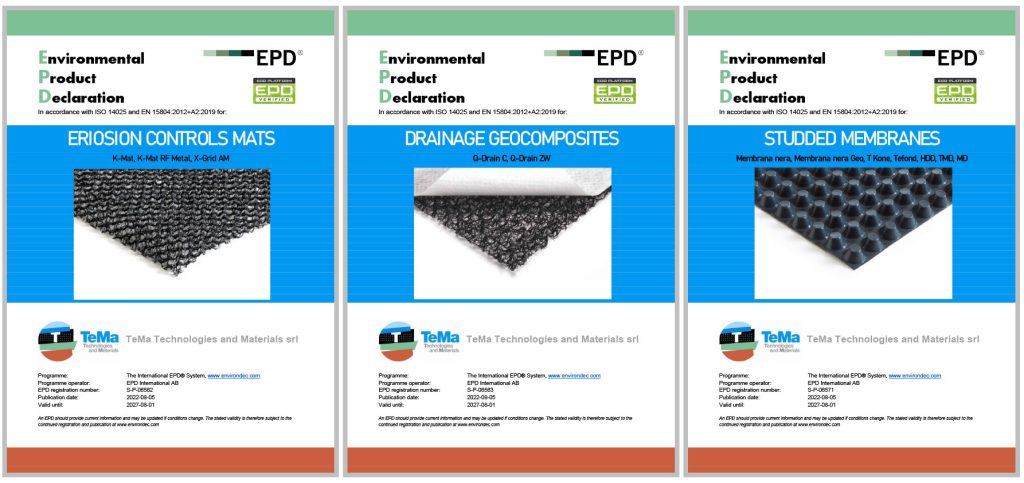
Our certificates can always be consulted by clicking here and entering TeMa in the filters.
- Published in CORPORATION, news, TeMa Technologies and Materials
TeMa: a support for the ground
Geo Solutions is the TeMa division that has been developing technologies and products for protection, maintenance and drainage in the field of major environmental works for over twenty years.
A SPECIAL FOCUS ON THE TERRITORY
More specifically, due to the location of its first production unit – situated near the hills that are now a UNESCO World Heritage Site – TeMa has always kept an eye on agricultural lands and especially wine-producing landscapes, which are now gaining increasing attention because of their economic importance and their environmental value.
This new focus on the landscape, including the agricultural one, has never been as relevant as now. We have officially entered the green year and therefore, today, we want to show you some systems for preserving your wine crops.

THE MAIN RISKS: EROSION AND DRAINAGE
The main risks that undermine the stability of the soil include: the natural erosion of the topsoil with the resulting need to reinforce it and the problem of water drainage.
EROSION: CAUSES AND SOLUTIONS
Soil erosion is caused by rainwater runoff, which, by removing the top layer of the soil, can cause significant erosion in the long term.
Various applications are available that provide protection against soil erosion. TeMa proposes natural and synthetic solutions, depending on the circumstances: a 100% natural jute fibre bionet can be used, or a three-dimensional PP geomat, such as KMat. A system of geosynthetic reinforcements (woven geotextiles or geogrids), once embedded in the subsoil, recreates a tensional layer that absorbs any stress of greater intensity than the soil.
DRAINAGE: CONSEQUENCES AND SOLUTIONS
Finally, to solve the fundamental cause of soil instability, namely drainage, TeMa has developed drainage trenches capable of removing water that is naturally absorbed by the ground. These are trench excavations, usually rectangular in section, filled with natural inert material, such as gravel or broken stones from quarries, with a high degree of permeability. Removal takes place either through the trench filling material or through the drainage pipe located at the base of the trench. To avoid another possible problem, i.e. clogging of the pipe, it is entirely covered with layers of non-woven fabric.

WHY CHOOSE TeMa?
Its attention to details, to small things, sets one company apart from all others. This is why TeMa stands out in its sector, thanks to its drive towards innovation and its respect for the environment, whose landscapes are unchanged after intervention works by TeMa.
Find out more, explore the TeMa website.
- Published in GEO, Landfills, news, Research and development, Synthetic turf soccer fields - Accessories

